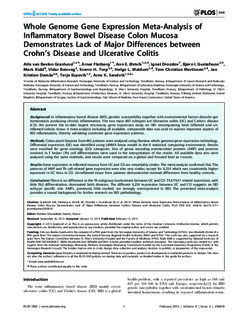| dc.contributor.author | Granlund, Atle Van Beelen | |
| dc.contributor.author | Flatberg, Arnar | |
| dc.contributor.author | Østvik, Ann Elisabet | |
| dc.contributor.author | Drozdov, Ignat | |
| dc.contributor.author | Gustafsson, Björn | |
| dc.contributor.author | Kidd, Mark | |
| dc.contributor.author | Beisvag, Vidar | |
| dc.contributor.author | Torp, Sverre Helge | |
| dc.contributor.author | Waldum, Helge | |
| dc.contributor.author | Martinsen, Tom Christian | |
| dc.contributor.author | Damås, Jan Kristian | |
| dc.contributor.author | Espevik, Terje | |
| dc.contributor.author | Sandvik, Arne Kristian | |
| dc.date.accessioned | 2015-11-20T11:03:40Z | |
| dc.date.accessioned | 2016-06-02T12:39:14Z | |
| dc.date.available | 2015-11-20T11:03:40Z | |
| dc.date.available | 2016-06-02T12:39:14Z | |
| dc.date.issued | 2013 | |
| dc.identifier.citation | PLoS ONE 2013, 8(2) | nb_NO |
| dc.identifier.issn | 1932-6203 | |
| dc.identifier.uri | http://hdl.handle.net/11250/2391240 | |
| dc.description.abstract | Background: In inflammatory bowel disease (IBD), genetic susceptibility together with environmental factors disturbs gut
homeostasis producing chronic inflammation. The two main IBD subtypes are Ulcerative colitis (UC) and Crohn’s disease
(CD). We present the to-date largest microarray gene expression study on IBD encompassing both inflamed and uninflamed
colonic tissue. A meta-analysis including all available, comparable data was used to explore important aspects of
IBD inflammation, thereby validating consistent gene expression patterns.
Methods: Colon pinch biopsies from IBD patients were analysed using Illumina whole genome gene expression technology.
Differential expression (DE) was identified using LIMMA linear model in the R statistical computing environment. Results
were enriched for gene ontology (GO) categories. Sets of genes encoding antimicrobial proteins (AMP) and proteins
involved in T helper (Th) cell differentiation were used in the interpretation of the results. All available data sets were
analysed using the same methods, and results were compared on a global and focused level as t-scores.
Results: Gene expression in inflamed mucosa from UC and CD are remarkably similar. The meta-analysis confirmed this. The
patterns of AMP and Th cell-related gene expression were also very similar, except for IL23A which was consistently higher
expressed in UC than in CD. Un-inflamed tissue from patients demonstrated minimal differences from healthy controls.
Conclusions: There is no difference in the Th subgroup involvement between UC and CD. Th1/Th17 related expression, with
little Th2 differentiation, dominated both diseases. The different IL23A expression between UC and CD suggests an IBD
subtype specific role. AMPs, previously little studied, are strongly overexpressed in IBD. The presented meta-analysis
provides a sound background for further research on IBD pathobiology. | nb_NO |
| dc.language.iso | eng | nb_NO |
| dc.publisher | Public Library of Science | nb_NO |
| dc.rights | Navngivelse 3.0 Norge | * |
| dc.rights.uri | http://creativecommons.org/licenses/by/3.0/no/ | * |
| dc.title | Whole Genome Gene Expression Meta-Analysis of Inflammatory Bowel Disease Colon Mucosa Demonstrates Lack of Major Differences between Crohn's Disease and Ulcerative Colitis | nb_NO |
| dc.type | Journal article | nb_NO |
| dc.type | Peer reviewed | nb_NO |
| dc.date.updated | 2015-11-20T11:03:40Z | |
| dc.source.volume | 8 | nb_NO |
| dc.source.journal | PLoS ONE | nb_NO |
| dc.source.issue | 2 | nb_NO |
| dc.identifier.doi | 10.1371/journal.pone.0056818 | |
| dc.identifier.cristin | 1029422 | |
| dc.relation.project | Norges forskningsråd: 223255 | nb_NO |
| dc.description.localcode | © 2013 Granlund et al. This is an open-access article distributed under the terms of the Creative Commons Attribution License, which permits unrestricted use, distribution, and reproduction in any medium, provided the original author and source are credited. | nb_NO |

